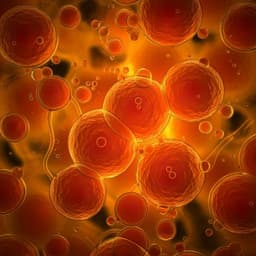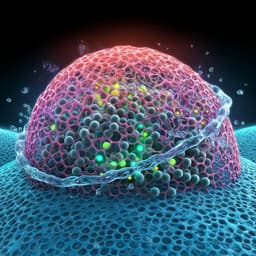
Chemistry
Self-regulated co-assembly of soft and hard nanoparticles
Y. Cui, H. Zhu, et al.
Discover how Yan Cui, Hongyan Zhu, Jiandong Cai, and Huibin Qiu unveil the potential of colloidal particles and block copolymer micelles in creating advanced materials with intricate structures. Their innovative approach harnesses noncovalent interactions to engineer complex, multidimensional assemblies that could revolutionize material science.
~3 min • Beginner • English
Introduction
The study addresses the long-standing challenge of programming the self-assembly of simple nanoparticles without complex, directional surface patterning. Conventional approaches rely on patchy particles or shape-specific building blocks to achieve directional bonding, but nanoscale regioselective functionalization and shape-controlled syntheses are difficult and limit broader application. Building on earlier observations that P2VP-corona block copolymer micelles can bind silica surfaces via hydrogen bonding, the authors propose a general, minimal-instruction co-assembly paradigm. Soft polystyrene-b-poly(2-vinylpyridine) (PS-b-P2VP) micelles associate with unfunctionalized hard nanoparticles (e.g., silica, gold, MOFs) through noncovalent interactions, creating emergent directional interactions and tunable valence controlled by particle size and mixing stoichiometry. The goal is to achieve predictable formation of colloidal molecules, polymers, and hierarchical superstructures in solution and on surfaces.
Literature Review
Prior work demonstrated diverse colloidal architectures (clusters, 1D chains, 2D/3D superstructures) often enabled by directional modules introduced via patchy particle surfaces or anisotropic geometries. Strategies include regioselective surface encoding, Janus/patchy particles, and lock-and-key colloids, but these require complex nanoscale fabrication. Alternative stoichiometry-driven assembly and self-limiting bonding have emerged recently. Specific to polymer-nanoparticle systems, PS-b-P2VP micelles with P2VP coronas can hydrogen-bond to silica surfaces (pyridyl–silanol interactions) to form core–satellite structures. These precedents motivate exploiting intrinsic micelle–NP interactions to bypass bespoke surface patterning while retaining control over assembly.
Methodology
Soft-hard co-assembly in solution: Block copolymer micelles (S_mV_n = PS_m-b-P2VP_n) were prepared in ethanol. Hard nanoparticles (silica, Au, silica-coated Au, polydopamine, and ZIF-8) were dispersed in ethanol or water. Defined numbers of soft and hard NPs were mixed under vigorous stirring to ensure uniformity, then aged prior to characterization (TEM, SEM, AFM). For example, BA2 trimers were formed by injecting ethanol solutions of 50-nm silica NPs into ethanol solutions of S2090V380 micelles with stirring, followed by 12 h mild stirring at room temperature. To obtain extended 2D networks, 3D stacked monoliths, or micelle-capped clusters, co-assembly was conducted at 80 °C in sealed vials to weaken hydrogen bonding and slow association kinetics.
Primary assemblies were explored by varying the A:B number ratio (A = S2090V380 micelles, B = silica NPs of 50, 75, 90 nm). The resultant structures were mapped across ratios from micelle- or silica-capped colloidal molecules (AB2, AB3, BA2, BA3, BA4) to alternating colloidal copolymers and networks.
Secondary (hierarchical) co-assembly: Primary colloidal molecules (e.g., BA2 trimers, BA3 tetramers, AB2 and AB3 cores) were combined with SV micelles or other primary molecules to construct core–arm conjugates (e.g., B(BA2)3, B(BA3)3, (AB2)A2, (AB2)(BA2)2, (AB2)(BA3)2, (AB3)A3, (AB3)(BA2)3, (AB3)(BA3)3).
Tunable materials scope: The approach was extended by mixing SV micelles (e.g., S2040V1590, S1520V370, S460V190, S1220V440, S2090V380, S1030V150) with hard NPs including 47–57 nm Au (coordination with pyridyl groups), silica-coated Au, PDA, and 53–70 nm ZIF-8 MOF NPs (hydrogen bonding and Zn(II)–pyridyl coordination), yielding dimers, trimers, higher-valence colloidal molecules, and copolymers.
On-surface assembly: Silicon wafers (0.5 × 0.5 cm) were cleaned (acetone, water), O2-plasma treated (10 min), then spin-coated with a diluted ethanol solution of S2090V380 micelles (6000 rpm, 1 min) and aged 12 h. Surface silanols on uncoated regions were passivated by FDTS vapor fluorination (2 h under vacuum), switching the contact angle from 45° to 112°. The micelle-coated, fluorinated wafers were sequentially immersed in ethanol solutions of 60-nm silica NPs (2 h; yielding AB dimers) and then S2160V620 micelles (2 h; yielding BA2 trimers), with ethanol rinses between steps. A complementary grafting-to method was performed by immersing the micelle-coated, fluorinated wafer into ethanol solutions (15 h) of silica-NP-capped colloidal oligomers (from 67-nm silica NPs and S2090V380 micelles), producing colloidal brushes of tunable length.
Key Findings
• Emergent Janus intermediates: Binding of a S2090V380 micelle to a silica NP yields a Janus-like entity that confers directional interactions, enabling controlled co-assembly without pre-patterned patches.
• Valence programmable by size and stoichiometry: With S2090V380 micelles, 50-nm silica NPs reach a saturated valence of 2 (BA2 trimers/pentamers not observed), 75-nm silica NPs reach valence 3 (BA3 tetramers), and 90-nm silica NPs reach valence 4 (BA4 pentamers). The valence evolves with the A:B mixing ratio: low A:B (≈1:3–1:2) yields silica-NP-capped AB2/AB3 colloidal molecules; near 1:1 produces alternating colloidal polymers and highly branched chains; high A:B (≥2:1) yields micelle-capped BA2 (for 50 nm), BA3 (for 75 nm), and BA4 (for 90 nm) with the central silica surface saturated by P2VP coronas.
• Dynamic valence and network formation: At intermediate ratios (e.g., 75-nm at ~3:2; 90-nm at ~2:1), higher-valence silica poles link multiple micelles to form extended 2D networks and 3D stacked monoliths under appropriate conditions.
• Corona length effect: Increasing P2VP corona length decreases saturated valence due to larger surface coverage per micelle.
• Hierarchical secondary assembly: Core–arm colloidal conjugates were constructed, including B(BA2)3, B(BA3)3, (AB2)A2, (AB2)(BA2)2, (AB2)(BA3)2, (AB3)A3, (AB3)(BA2)3, and (AB3)(BA3)3, demonstrating modular growth of complex architectures.
• Materials generality via noncovalent interactions: SV micelles co-assembled controllably with 47–57 nm Au NPs (AC dimers, CA2 trimers, CA3 tetramers, copolymers via pyridyl–Au coordination), silica-coated Au NPs (micelle-capped trimers and alternating copolymers), PDA NPs (core–satellite structures), and 53–70 nm ZIF-8 NPs (DA2, DA4, DA6, and copolymers via H-bonding and Zn(II)–pyridyl coordination). Mixed systems yielded multicompartment conjugates such as C(BA2)2 and D(BA2)3.
• On-surface programmability: Sequential immersion on micelle-anchored, FDTS-fluorinated silicon wafers produced AB dimers and BA2 trimers; grafting-to yielded colloidal brushes whose length was tuned by the oligomer degree of polymerization.
Discussion
The findings demonstrate that directional, valence-limited bonding can emerge from simple noncovalent interactions between soft P2VP coronas and unfunctionalized hard nanoparticle surfaces. The initial micelle–silica association creates a Janus intermediate that provides anisotropy, allowing programmable growth dictated by particle size and feeding stoichiometry. The balance between adhesive hydrogen bonding/coordination and repulsive inter-corona/solvent forces governs dynamic valence, enabling transitions from discrete colloidal molecules to alternating copolymers and extended networks. This approach bypasses the need for complex surface patterning or anisotropic particle synthesis while maintaining precise control over architecture. Its generality across diverse hard nanoparticles (silica, Au, ZIF-8, PDA) and compatibility with hierarchical and on-surface assembly highlight broad applicability for constructing multifunctional, multicomponent colloidal superstructures.
Conclusion
This work introduces a versatile, self-regulated co-assembly paradigm wherein PS-b-P2VP micelles associate with unfunctionalized hard nanoparticles via hydrogen bonding and/or coordination to produce colloidal molecules, polymers, and hierarchical superstructures with programmable valence defined by relative size and stoichiometry. Primary assemblies (e.g., AB2, AB3, BA2–BA4, alternating copolymers) can be hierarchically connected into core–arm conjugates, and the method extends to functional nanoparticles (Au, ZIF-8, PDA). On-surface protocols enabled sequential synthesis of AB and BA2 structures and grafted colloidal brushes. Future work could expand material combinations, refine sequence-controlled on-surface syntheses of longer, less distorted oligomers, explore stimulus-responsive or dynamic reconfigurable assemblies, and integrate functional payloads for application-driven colloidal materials.
Limitations
On-surface growth beyond BA2 trimers was limited by distortion of BA2 structures (often adopting a “v” shape), hindering further sequential extension. Assembly relies on noncovalent interactions (e.g., hydrogen bonding, coordination) that are sensitive to solvent and temperature; achieving certain extended architectures required elevated temperature (80 °C) to weaken hydrogen bonding and slow association. The saturated valence depends on corona length and particle size, constraining achievable architectures under fixed conditions.
Related Publications
Explore these studies to deepen your understanding of the subject.







